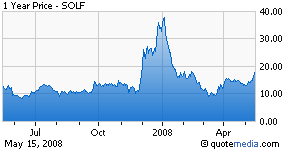Virtually all of the solar companies which have reported recently have reported better than expected earnings. Canadian Solar (CSIQ) trounced their earnings estimates. CSIQ is in a virtually identical segment of the business to Solarfun (SOLF). According to theStreet.com analyses on TD Ameritrade, SOLF has slightly better margins than CSIQ. This would lead one to believe that SOLF is likely to have much better than expected earnings this quarter. With the price of the stock currently sitting on (or near) the trigger point for most short sale buy backs, a move up with earnings might well trigger a big short squeeze. I note the current price of SOLF at this writing is approx. $18.50. Likely most shorts were sold at or below this price.

The current short squeeze situation was set up on Jan. 24, 2008. SOLF sold $150,000,000 worth of convertible notes priced at $19.13. At the same time, SOLF lent 7.8 million shares to Morgan Stanley to sell to the bond investors to hedge their positions. For instance, bond investors could collect the interest on the note, but short the stock close to the $19.13 price to prevent themselves from losing money as the stock went down in a down market. Apparently this is what happened. During the ensuing down market, the short positions on SOLF deepened further. TD Ameritrade currently shows approximately 15 million shares are shorted (about 35% of the float). Currently SOLF is trading at about 15 times 2009 earnings estimates, so it has room to move up. If SOLF guides higher after reporting good earnings, the stock may move much higher.
The possible downside view may be the margins. Both CSIQ and SOLF have low margins. Some people are wondering how they are going to do in the future as solar gets cheaper. Can they compete? Certainly a lot of people have shorted CSIQ, even though it continues to go up. What can make other people believe that CSIQ and SOLF have a good future?
The answer for CSIQ is that it is planning to start making UMG solar, which is much cheaper to manufacture. It is planning to ship 30-40MW of UMG solar in 2008. It will build this amount to 200MW in 2009. I haven’t heard that SOLF has any UMG plans yet, but it seems like just a matter of time. In addition Good Energies owns big stakes in both Trina Solar (TSL) and SOLF. Many are predicting solar company mergers, so companies can compete better. Many think SOLF and TSL are a marriage made in “Good Energy”. If that merger happens, it will likely help both companies. TSL recently scrapped its plans to build a poly plant. I think the UMG technology may have been part of the reason. The definitive work on UMG seems to be “Silicon LPE On Substrates From Metallurgical Silicon Feedstock For Large Scale Production” by M. Muller, R. Kopecek, P. Fath, C. Zahedi, and K. Peter from the University of Konstanz, Department of Physics. Apparently after upgrading the metallurgical silicon to PV-grade (PVG-Si), it can be used as feedstock without the need for complex high cost chlorosilane process to purify the product. Such low cost feedstock gives a reasonable efficiency solar cell [1], provided a high purity thin silicon layer is grown on the multicrystalline substrate wafers, which is made of PVG-Si by conventional ingot casting and wafering. Electrical grade silicon is 99.99999 plus percent pure, but it costs $150 to $250 a kilogram.
Only around 70,000 tons are manufactured worldwide. By contrast, upgraded metallurgical silicon is only 99 percent or so percent pure and goes for $20 to $50 a kilo. Approximately 1.2 million tons get made a year.
This seems to be the development path that CSIQ has elected to follow. Other companies such as SOLF and TSL are sure to follow. A company like LDK Solar (LDK) will likely use its coming poly plant to increase its margins. Then it will start on this new technology (perhaps before then) in combination with its poly plant to further increase margins. Ditto MEMC Electronic Materials (WFR). Both of these companies should be able to compete well with all of the other new technologies, such as CIGS. The solar made in this way has a slightly lower conversion efficiency. However, that efficiency is still very competitive with CIGS technology. Watch out First Solar (FSLR)! The competition is coming.
In sum, the UMG technology means that there is still a bright future for companies such as CSIQ and SOLF. It means that all of the polysilicone solar manufacturers will not suddenly be put out of business by newer technologies such as CIGS. It means that FSLR, which trades at 54 times 2009 earnings, may have lost its edge.
I think SOLF can be bid up in a short squeeze at its pivot point because it looks like it has a bright future if it just follows the crowd. If it can produce good results now, good results look very probable in the future. It has a lot of good contracts and good customer relationships. It just needs to execute. A merger with TSL might well help. Such a possible merger is another reason the stock price may rise.




